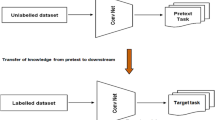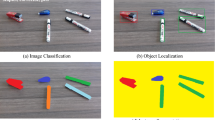Abstract
To solve the long-tail distribution problem in domain adaptive semantic segmentation, we propose a novel multilevel class balancing network (MLCB-Net). We adapt a novel frequency fusion module (FFM) by using prior knowledge to guide the domain adaptive semantic segmentation network, thus carrying out regular constraints in global training. Furthermore, in the domain adaptation process, we introduce a dual-branch balancing module (DBBM) to resample the class-level features, which makes the model not only improve the sensitivity to low-frequency classes but also does not damage the feature representation ability of the classifier. In addition, we combine self-supervised learning strategies with our proposed modules to further improve segmentation performance. Experiments on two baseline tasks, GTA5 to Cityscapes and SYNTHIA to Cityscapes, show that MLCB-Net achieves a new state-of-the-art benchmark and is more robust.





Similar content being viewed by others
Data availability
The datasets generated and analyzed during the current study are available from the corresponding author on reasonable request.
References
Luo, Y., Zheng, L., Guan, T., Yu, J., Yang, Y.: Taking a closer look at domain shift: Category-level adversaries for semantics consistent domain adaptation. In: Proceedings of the IEEE Conference on Computer Vision and Pattern Recognition, pp. 2507–2516 (2019)
Zhang, J., Li, W., Li, Z.: Distinguishing foreground and background alignment for unsupervised domain adaptative semantic segmentation. Image Vis. Comput. 124, 104513 (2022)
Patel, V.M., Gopalan, R., Li, R., Chellappa, R.: Visual domain adaptation: a survey of recent advances. IEEE Signal Process. Mag. 32(3), 53–69 (2015)
Geng, B., Tao, D., Xu, C.: Daml: domain adaptation metric learning. IEEE Trans. Image Process. 20(10), 2980–2989 (2011)
Maria Carlucci, F., Porzi, L., Caputo, B., Ricci, E., Rota Bulo, S.: Autodial: Automatic domain alignment layers. In: Proceedings of the IEEE International Conference on Computer Vision, pp. 5067–5075 (2017)
Mancini, M., Porzi, L., Bulo, S.R., Caputo, B., Ricci, E.: Boosting domain adaptation by discovering latent domains. In: Proceedings of the IEEE Conference on Computer Vision and Pattern Recognition, pp. 3771–3780 (2018)
Zhang, J., Li, Z., Zhang, C., Ma, H.: Stable self-attention adversarial learning for semi-supervised semantic image segmentation. J. Vis. Commun. Image Representation 78, 103170 (2021)
Richter, S.R., Vineet, V., Roth, S., Koltun, V.: Playing for data: Ground truth from computer games. In: Proceedings of European Conference on Computer Vision, pp. 102–118 (2016)
Ros, G., Sellart, L., Materzynska, J., Vazquez, D., Lopez, A.M.: The synthia dataset: A large collection of synthetic images for semantic segmentation of urban scenes. In: Proceedings of the IEEE Conference on Computer Vision and Pattern Recognition, pp. 3234–3243 (2016)
Cordts, M., Omran, M., Ramos, S., Rehfeld, T., Enzweiler, M., Benenson, R., Franke, U., Roth, S., Schiele, B.: The cityscapes dataset for semantic urban scene understanding. In: Proceedings of the IEEE Conference on Computer Vision and Pattern Recognition, pp. 3213–3223 (2016)
Brostow, G.J., Shotton, J., Fauqueur, J., Cipolla, R.: Segmentation and recognition using structure from motion point clouds. In: Proceedings of European Conference on Computer Vision, pp. 44–57 (2008)
Hoffman, J., Wang, D., Yu, F., Darrell, T.: Fcns in the wild: Pixel-level adversarial and constraint-based adaptation. arXiv preprint arXiv:1612.02649 (2016)
Tsai, Y.-H., Hung, W.-C., Schulter, S., Sohn, K., Yang, M.-H., Chandraker, M.: Learning to adapt structured output space for semantic segmentation. In: Proceedings of the IEEE Conference on Computer Vision and Pattern Recognition, pp. 7472–7481 (2018)
Pan, F., Shin, I., Rameau, F., Lee, S., Kweon, I.S.: Unsupervised intra-domain adaptation for semantic segmentation through self-supervision. In: Proceedings of the IEEE Conference on Computer Vision and Pattern Recognition, pp. 3764–3773 (2020)
Hoffman, J., Tzeng, E., Park, T., Zhu, J.-Y., Isola, P., Saenko, K., Efros, A., Darrell, T.: Cycada: Cycle-consistent adversarial domain adaptation. In: Proceedings of International Conference on Machine Learning, pp. 1989–1998 (2018)
Zhang, Y., David, P., Gong, B.: Curriculum domain adaptation for semantic segmentation of urban scenes. In: Proceedings of the IEEE International Conference on Computer Vision, pp. 2020–2030 (2017)
Chen, S., Li, Z., Yang, X.: Knowledge reasoning for semantic segmentation. In: ICASSP 2021-2021 IEEE International Conference on Acoustics, Speech and Signal Processing (ICASSP), IEEE, pp. 2340–2344 (2021)
Zhu, J.-Y., Park, T., Isola, P., Efros, A.A.: Unpaired image-to-image translation using cycle-consistent adversarial networks. In: Proceedings of the IEEE International Conference on Computer Vision, pp. 2223–2232 (2017)
Isola, P., Zhu, J.-Y., Zhou, T., Efros, A.A.: Image-to-image translation with conditional adversarial networks. In: Proceedings of the IEEE Conference on Computer Vision and Pattern Recognition, pp. 1125–1134 (2017)
Li, Y., Yuan, L., Vasconcelos, N.: Bidirectional learning for domain adaptation of semantic segmentation. In: Proceedings of the IEEE Conference on Computer Vision and Pattern Recognition, pp. 6936–6945 (2019)
Paul, S., Tsai, Y.-H., Schulter, S., Roy-Chowdhury, A.K., Chandraker, M.: Domain adaptive semantic segmentation using weak labels. arXiv preprint arXiv:2007.15176 (2020)
Wang, Z., Yu, M., Wei, Y., Feris, R., Xiong, J., Hwu, W.-m., Huang, T.S., Shi, H.: Differential treatment for stuff and things: A simple unsupervised domain adaptation method for semantic segmentation. In: Proceedings of the IEEE Conference on Computer Vision and Pattern Recognition, pp. 12635–12644 (2020)
Xu, Y., Du, B., Zhang, L., Zhang, Q., Wang, G., Zhang, L.: Self-ensembling attention networks: Addressing domain shift for semantic segmentation. In: Thirty-Third AAAI Conference on Artificial Intelligence (2019)
Gao, L., Zhang, J., Zhang, L., Tao, D.: Dsp: Dual soft-paste for unsupervised domain adaptive semantic segmentation. Proceedings of the 29th ACM International Conference on Multimedia (2021). https://doi.org/10.1145/3474085.3475186
Zhang, Q., Zhang, J., Liu, W., Tao, D.: Category anchor-guided unsupervised domain adaptation for semantic segmentation. Advances in Neural Information Processing Systems 32, arXiv1910.13049 (2019)
Chen, S., Li, Z., Tang, Z.: Relation r-cnn: a graph based relation-aware network for object detection. IEEE Signal Process. Lett. 27, 1680–1684 (2020)
Kang, B., Xie, S., Rohrbach, M., Yan, Z., Gordo, A., Feng, J., Kalantidis, Y.: Decoupling representation and classifier for long-tailed recognition. arXiv preprint arXiv:1910.09217 (2019)
Zhou, B., Cui, Q., Wei, X.-S., Chen, Z.-M.: Bbn: Bilateral-branch network with cumulative learning for long-tailed visual recognition. In: Proceedings of the IEEE Conference on Computer Vision and Pattern Recognition, pp. 9719–9728 (2020)
Cui, Y., Jia, M., Lin, T.-Y., Song, Y., Belongie, S.: Class-balanced loss based on effective number of samples. In: Proceedings of the IEEE Conference on Computer Vision and Pattern Recognition, pp. 9268–9277 (2019)
Jamal, M.A., Brown, M., Yang, M.-H., Wang, L., Gong, B.: Rethinking class-balanced methods for long-tailed visual recognition from a domain adaptation perspective. In: Proceedings of the IEEE Conference on Computer Vision and Pattern Recognition, pp. 7610–7619 (2020)
Tan, J., Wang, C., Li, B., Li, Q., Ouyang, W., Yin, C., Yan, J.: Equalization loss for long-tailed object recognition. In: Proceedings of the IEEE Conference on Computer Vision and Pattern Recognition, pp. 11662–11671 (2020)
Lin, T.-Y., Goyal, P., Girshick, R., He, K., Dollár, P.: Focal loss for dense object detection. In: Proceedings of the IEEE International Conference on Computer Vision, pp. 2980–2988 (2017)
Cai, Z., Fan, Q., Feris, R.S., Vasconcelos, N.: A unified multi-scale deep convolutional neural network for fast object detection. In: Proceedings of the European Conference on Computer Vision, pp. 354–370 (2016)
Lin, T.-Y., Dollár, P., Girshick, R., He, K., Hariharan, B., Belongie, S.: Feature pyramid networks for object detection. In: Proceedings of the IEEE Conference on Computer Vision and Pattern Recognition, pp. 2117–2125 (2017)
Lin, M., Chen, Q., Yan, S.: Network in network. arXiv preprint arXiv:1312.4400 (2013)
Chen, L.-C., Papandreou, G., Kokkinos, I., Murphy, K., Yuille, A.L.: Deeplab: semantic image segmentation with deep convolutional nets, atrous convolution, and fully connected crfs. IEEE Trans. Pattern Analy. Mach. Intell. 40(4), 834–848 (2017)
Kingma, D.P., Ba, J.: Adam: A method for stochastic optimization. arXiv preprint arXiv:1412.6980 (2014)
Du, L., Tan, J., Yang, H., Feng, J., Xue, X., Zheng, Q., Ye, X., Zhang, X.: Ssf-dan: Separated semantic feature based domain adaptation network for semantic segmentation. In: Proceedings of the IEEE International Conference on Computer Vision, pp. 982–991 (2019)
Lian, Q., Lv, F., Duan, L., Gong, B.: Constructing self-motivated pyramid curriculums for cross-domain semantic segmentation: A non-adversarial approach. In: Proceedings of the IEEE International Conference on Computer Vision, pp. 6758–6767 (2019)
Mei, K., Zhu, C., Zou, J., Zhang, S.: Instance adaptive self-training for unsupervised domain adaptation. In: Proceedings of the European Conference on Computer Vision, pp. 415–430 (2020)
Araslanov, N., Roth, S.: Self-supervised augmentation consistency for adapting semantic segmentation. In: Proceedings of the IEEE Conference on Computer Vision and Pattern Recognition, pp. 15384–15394 (2021)
Acknowledgements
This work is supported by the National Natural Science Foundation of China (Nos. 62276073, 61966004), the Guangxi Natural Science Foundation (No. 2019GXNSFDA245018), the Guangxi “Bagui Scholar” Teams for Innovation and Research Project, Guangxi Collaborative Innovation Center of Multi-source Information Integration and Intelligent Processing.
Author information
Authors and Affiliations
Corresponding author
Ethics declarations
Conflict of interest
We declare that we have no financial and personal relationships with other people or organizations that can inappropriately influence our work. There is no professional or other personal interest of any nature or kind in any product, service and/or company that could be construed as influencing the position presented in, or the review of, the manuscript entitled.
Additional information
Publisher's Note
Springer Nature remains neutral with regard to jurisdictional claims in published maps and institutional affiliations.
Rights and permissions
Springer Nature or its licensor (e.g. a society or other partner) holds exclusive rights to this article under a publishing agreement with the author(s) or other rightsholder(s); author self-archiving of the accepted manuscript version of this article is solely governed by the terms of such publishing agreement and applicable law.
About this article
Cite this article
Li, W., Yang, X. & Li, Z. MLCB-Net: a multi-level class balancing network for domain adaptive semantic segmentation. Multimedia Systems 29, 1405–1416 (2023). https://doi.org/10.1007/s00530-023-01055-4
Received:
Accepted:
Published:
Issue Date:
DOI: https://doi.org/10.1007/s00530-023-01055-4




